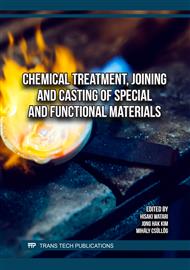[1]
Goldak, John, Aditya Chakravarti, and Malcolm Bibby, "A new finite element model for welding heat sources," Metallurgical transactions, vol. 15, pp.299-305,1984.
DOI: 10.1007/bf02667333
Google Scholar
[2]
Elfallah, s. S. S., "Study the influence of welding parameters by taguchi's design on the mechanical properties of welded mild steel (S235jr)", Jurnal teknologi, vol. 85, no.4, pp.55-66, 2023.
DOI: 10.11113/jurnalteknologi.v85.19653
Google Scholar
[3]
Alhafadhi, M., Alsigar, M., Vemanaboina, H., Mohanad, F. "Modeling and Measuring Residual Stresses in a Thick-Walled Pipe Structure Welded with a Buried-Arc Technique: A Comparative Study," Scientific Books of Abstracts, no.2, pp.7-7, 2023.
Google Scholar
[4]
Hasan Al-Hafadhi, M., Krallics, G.,"Prediction and numerical simulation of residual stress in multi-pass pipe welds. Pollack Periodica, vol. 16 no.2, pp.7-12, 2021.
DOI: 10.1556/606.2020.00127
Google Scholar
[5]
Alhafadhi, M. H., Krallics, G., "Simulation of the residual stress in a multi-pass oil and gas pipe weld joint," In Journal of Physics: Conference Series IOP Publishing, vol. 1527, no. 1, p.012005, 2020.
DOI: 10.1088/1742-6596/1527/1/012005
Google Scholar
[6]
Alhafadhi, M. H., Krallics, G., "Numerically simulated prediction of residual stresses in welding considering phase transformation effects," In Journal of Physics: Conference Series, vol. 1527, no. 1, pp.012-017, 2020.
DOI: 10.1088/1742-6596/1527/1/012017
Google Scholar
[7]
Alhafadhi, M., Krallics, G., "Finite element modelling of residual stresses in welded pipe welds with dissimilar materials," Hungarian materials and chemical sciences and engineering, vol. 45, no.4, pp.7-19, 2020.
Google Scholar
[8]
Alhafadhi, M. H., Krállics, G., "Effect of the welding parameters on residual stresses in pipe weld using numerical simulation," Design of machines and structures: a publication of the university of miskolc, vol. 10, no.1, pp.5-12., 2020.
DOI: 10.32972/dms.2020.001
Google Scholar
[9]
Alsigar, M., Alhafadhi, M., Pereverzev, P., Mohanad, F., "Optimizing Grinding Cycle Times for Maximum Efficiency through Dynamic Programming," Scientific Books of Abstracts, no.2, pp.12-12, 2023.
Google Scholar
[10]
Alsigar, M., Alhafadhi, M., Pereverzev, P., "Developing Optimal Automated Cycles for Achieving Maximum Efficiency Using Dynamic Programming," In International Conference on Industrial Engineering Cham: Springer Nature Switzerland, pp.542-554, 2024.
DOI: 10.1007/978-3-031-65870-9_50
Google Scholar
[11]
Alhafadhi, M. H., Krallics, G., "The effect of heat input parameters on residual stress distribution by numerical simulation," In IOP Conference Series: Materials Science and Engineering, vol. 613, no. 1, p.012035, 2019.
DOI: 10.1088/1757-899x/613/1/012035
Google Scholar
[12]
Alhafadhi, M. H., Krallics, G., "Numerical simulation prediction and validation two-dimensional model weld pipe," Machines. Technologies. Materials, vol. 13, no.10, pp.447-450, 2019.
Google Scholar
[13]
Lukács, J., Mobark, H. F. H., & Dobosy, Á., "High cycle fatigue resistance of 700 MPa and 960 MPa strength categories high strength steels and their gas metal arc welded joints," In Vehicle and Automotive Engineering 3: Proceedings of the 3rd VAE2020, Miskolc, Hungary, vol.3, pp.539-555, 2021.
DOI: 10.1007/978-981-15-9529-5_47
Google Scholar
[14]
Mobark, H. F. H., Dobosy, Á., Lukács, J., "Mismatch effect influence on the HCF resistance of high strength steels and their GMA welded joints," In Vehicle and Automotive Engineering 2: Proceedings of the 2nd VAE2018, Miskolc, Hungary, vol.3, pp.755-767, 2018.
DOI: 10.1007/978-3-319-75677-6_64
Google Scholar
[15]
Mobark, H., & Lukács, J., "Mismatch effect on fatigue crack propagation limit curves of GMAW joints made of S960QL and S960TM," Design of Machines and Structures, vol. 10, no.1, pp.28-38, 2020.
DOI: 10.32972/dms.2020.004
Google Scholar
[16]
Mobark, H. F. H., Lukács, J., "Efficient application of S690QL type high strength steel for cyclic loaded welded structures," In Solutions for Sustainable Development, pp.325-336, 2019.
DOI: 10.1201/9780367824037-39
Google Scholar
[17]
Mobark, H., & Lukács, J., "HCF design curves for high strength steel welded joints," Design of Machines and Structures, vol. 8, no.2, pp.39-51., 2018.
Google Scholar
[18]
Alden Abd Al Al, S., Meilinger, Á., Gáspár, M., "Physical Heat Cycle Measurement of Resistance Spot Welding," Key Engineering Materials, vol. 989, pp.65-75, 2024.
DOI: 10.4028/p-tb0owj
Google Scholar
[19]
Abd Al Al, S. A., Meilinger, Á., Gáspár, M., Lukács, J., "High Cycle Fatigue Testing of Lap Shear RSW Joints from Martensitic MS1400 Steel Sheets," In Materials Science Forum,vol. 1095, pp.139-151,2023.
DOI: 10.4028/p-o9mwsq
Google Scholar
[20]
Abd al al, S. A., Meilinger, Á., "Investigation of Resistance Spot Welded Joints Made on Ultra-high-Strength Steel Sheets," In Vehicle and Automotive Engineering, vol.1, no.1 pp.981-994, 2022.
DOI: 10.1007/978-3-031-15211-5_82
Google Scholar
[21]
Meilinger, Á., Prém, L., Abd Al Al, S. A., Gáspár, M., "Comparison of RSW technologies on DP steels with modified instrumented Charpy impact test," Welding in the World, vol.67, no.8, pp.1911-1922, 2023.
DOI: 10.1007/s40194-023-01526-2
Google Scholar
[22]
Alhafadhi, M., Alsigar, M., Zahraa A, O., Bézi, Z., Sahm, A. A. A., Reddy, P. R., "Influence of heat input and preheating on residual stresses in pipe weld," Pollack Periodica ,vol.19, no.2, pp.42-47, 2024.
DOI: 10.1556/606.2023.00589
Google Scholar



